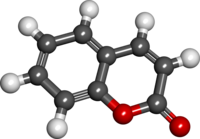Coumarins
 |
|
 |
|
 |
|
| Names | |
|---|---|
|
IUPAC name
2H-chromen-2-one
|
|
| Other names
1-benzopyran-2-one
|
|
| Identifiers | |
|
3D model (Jmol)
|
|
| ChEBI | |
| ChemSpider | |
| DrugBank | |
| ECHA InfoCard | 100.001.897 |
| EC Number | 202-086-7 |
| KEGG | |
|
PubChem CID
|
|
| RTECS number | GN4200000 |
| UNII | |
|
|
|
|
| Properties | |
| C9H6O2 | |
| Molar mass | 146.15 g·mol−1 |
| Appearance | colorless to white crystals |
| Odor | pleasant, like vanillabeans |
| Density | 0.935 g/cm3 (20 °C (68 °F)) |
| Melting point | 71 °C (160 °F; 344 K) |
| Boiling point | 301.71 °C (575.08 °F; 574.86 K) |
| 0.17 g/100 mL | |
| Solubility | very soluble in ether, diethyl ether, chloroform, oil, pyridine soluble in ethanol |
| log P | 1.39 |
| Vapor pressure | 1.3 hPa (106 °C (223 °F)) |
| −82.5×10−6 cm3/mol | |
| Structure | |
| orthorhombic | |
| Hazards | |
| Safety data sheet | Sigma-Aldrich |
| NFPA 704 | |
| Flash point | 150 °C (302 °F; 423 K) |
| Lethal dose or concentration (LD, LC): | |
|
LD50 (median dose)
|
293 mg/kg (rat, oral) |
| Related compounds | |
|
Related compounds
|
Chromone |
|
Except where otherwise noted, data are given for materials in their standard state (at 25 °C [77 °F], 100 kPa).
|
|
|
|
|
| Infobox references | |
Coumarin (/ˈkuːmərɪn/; 2H-chromen-2-one) is a fragrant organic chemical compound in the benzopyrone chemical class, which is a colorless crystalline substance in its standard state. It is a natural substance found in many plants.
The name comes from a French term for the tonka bean, coumarou, one of the sources from which coumarin was first isolated as a natural product in 1820. It has a sweet odor, readily recognised as the scent of newly-mown hay, and has been used in perfumes since 1882. Sweet woodruff, meadowsweet, sweet grass and sweet-clover in particular are named for their sweet (i.e., pleasant) smell, which in turn is due to their high coumarin content. When it occurs in high concentrations in forage plants, coumarin is a somewhat bitter-tasting appetite suppressant, and is presumed to be produced by plants as a defense chemical to discourage predation.
Coumarin is used in certain perfumes and fabric conditioners. Coumarin has been used as an aroma enhancer in pipe tobaccos and certain alcoholic drinks, although in general it is banned as a flavorant food additive, due to concerns regarding its hepatotoxicity in animal models.
Coumarin was first synthesized in 1868. It is used in the pharmaceutical industry as a precursor reagent in the synthesis of a number of synthetic anticoagulant pharmaceuticals similar to dicoumarol, the notable ones being warfarin (brand name Coumadin) and some even more potent rodenticides that work by the same anticoagulant mechanism. 4-hydroxycoumarins are a type of vitamin K antagonist. Pharmaceutical (modified) coumarins were all developed from the study of sweet clover disease; see warfarin for this history. However, unmodified coumarin itself, as it occurs in plants, has no effect on the vitamin K coagulation system, or on the action of warfarin-type drugs.
...
Wikipedia

